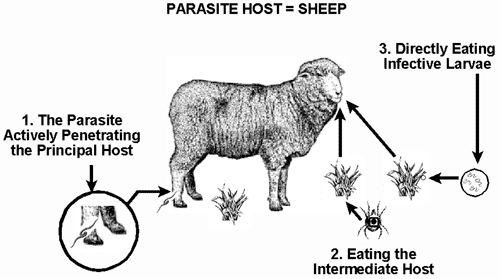
Introduction:
It is important to realize that each region of the country will have different parasite problems and potentially different prevention/treatment programs. Therefore, it is important to involve a local veterinarian in all parasite control programs. Proper nutrition is of extreme importance in the control of the effects of parasitism. Animals in good condition and receiving adequate feed are often able to establish some resistance to internal parasites. Poorly fed animals are unable to cope with parasitism, and death losses are often great. Parasitic disease problems increase with intensification of production and lack of attention to strict sanitation.Causative Agents: In general, parasites can be broken into two major categories: internal parasites (endoparasites) and external parasites (ectoparasites). Each parasite is then further classified into additional groups according to their structure, growth, and life cycles.
Internal parasites - general: Internal parasites may be divided into four (4) classifications:
The roundworms are by far the most economically important internal parasites of sheep and goats. Flukes produce damage of economic importance in some geographic areas, while adult tapeworms are usually of minor importance. The following lists contain some of the most common parasites found in small ruminants. These lists do not contain all possible parasites.
Internal Parasites Common to Sheep and Goats:
Roundworms - Nematodes:
Tapeworms (adult and larvae) - Cestodes:
Flukes - Trematodes:
Protozoa - Coccidia:
External Parasites Common to Sheep and Goats:
Locations of Common Stomach and Intestinal Roundworms:
Abomasum:
Haemonchus
Ostertagia
Trichostrongylus
Large intestine:
Oesophagostomum
Chabertia
Small intestine:
Trichostrongylus
Nematodirus
Bunostomum
Caecum:
Trichuris
Clinical Signs:
Signs of parasite infestation are most common in young, very old, or diseased animals. Each infected animal, depending on the parasite or parasites it is infected with, will have different signs of disease. In general, most infections cause weight loss, unthriftiness, and poor weight gains. Some parasites can cause diarrhea, decreased appetite, poor conception rates, and fluid retention (bottle jaw). Parasites can also cause poor fiber production.Disease Transmission:
Some internal parasites are spread by orally ingesting the infective stage of the parasite. This most commonly occurs during grazing. External parasites and some internal parasites are spread by direct contact or having infested animals in close association with other animals. The following diagram shows the various routes that are commonly used by parasites to enter the host animal.
Diagnosis:
Fundamentals of Internal Parasite Control: When considering the prevention of internal parasite infections, it is important to focus on two major areas:
Avoid Contaminated Pasture: Susceptible sheep and goats should be moved to "safe" (parasite free) pasture at critical times. The following grazing areas are listed in order from the most parasite free, to the areas where parasite numbers can be excessive:
Prevent Pasture Contamination: Parasite eggs are deposited on pasture by worm-infected sheep or goats. The parasites are then spread to other animals when they ingest the infective stage of the parasite. To prevent eggs from contaminating pasture and infecting other animals, de-worming is an essential part of management. (See page C174 for drenching procedures.) When animals are de-wormed, then moved to a safe pasture (stubble or cattle pasture), they will not significantly contaminate the pasture with eggs for several months. Because of the added stress placed on the ewe/doe after lambing or kidding, an increase in parasite egg shedding is often noticed. Proper management of these females prior to and after giving birth can help reduce egg shedding and pasture contamination.
Treatment/Prevention: The following recommendations are the general basis of parasite control. They are not intended to be rigid guidelines and should be varied, even between pastures on individual farms or ranches where experience indicates that more or less control is needed. Also, the timing of de-worming may be altered to suit individual producer needs. All these decisions should be made with the help of a local veterinarian. Many of the products that are discussed in this manual are not approved for goats and sheep. Therefore, their use would be considered extra label. Many times, goats require doses that are 1.5 times higher than the typical sheep dose for many of the internal parasite products. Some veterinarians recommend giving only oral internal parasite products to goats. Studies indicate that many of the pour-on products are not very effective in sheep and goats. Refer to Section G for dosage information.
The Following Practices are Recommend in All Areas:
De-worming Program for Internal Parasites:
In general, there are four common times when animals are de-wormed:Products Used to Treat Internal Parasites:
Different treatments are based on the common parasites encountered and geographical location. The following table identifies the most common products used for parasite control and what parasites they are effective against.| Brand Name (Active Ingredient) | **Effective Against |
| *Ivomec Sheep Drench (Ivermectin) | # 1-11, 21, 25 |
| *Tramisol or Levasole (Levamisole) | # 1-7, 9, 10 |
| *Bovatec (Lasalocid Sodium) | # 19 |
| *Rumensin (Monensin) | # 19 |
| *Corid (Amprolium) | # 19 |
| *Dectomax (Doramectin) | # 1-11, 21 |
| *Valbazen (Albendazole) | # 1-4, 7, 10, 12, 18 |
| *Panacur (Fenbendazole) | # 1-4, 7, 10-12 |
* Many of these products are not labeled for use in goats and often sheep. Their use in these cases is considered "extra-label."
** These numbers correspond with the numbers above.
Products Used to Treat External Parasites:
Most external parasites are controlled on a flock/herd wide basis. This means that when one animal is diagnosed with external parasites, a dip, dust, or spray is used to treat the problem that animal as well as the entire flock/herd. The following table outlines the common products and the treatments used to treat the external parasites:| Active Ingredient | Effective Against | **Treatments |
| *Malathion | Mites, lice, keds | 0.5% spray; 4% dust |
| *Lime-sulfur | Mites, lice, keds | 2-5% dip |
| *Coumaphos | Mites, lice, keds | 0.05-0.3% spray or dip; 0.5%-1% dust |
| *Phosmet | Mites, lice, keds | 0.15-0.25% dip |
| *Methoxychlor | Mites, lice, keds, ticks | 0.5% spray or dip; 5% dust |
* These products are not labeled for use in sheep and goats. Their use in these animals is considered "extra-label."
** Many of the dose recommendations used came from Pugh DG: Sheep & Goat Medicine, Ed 1, Philadelphia, 2002, WB Saunders.
Internal Parasite Life Cycles:
Roundworm
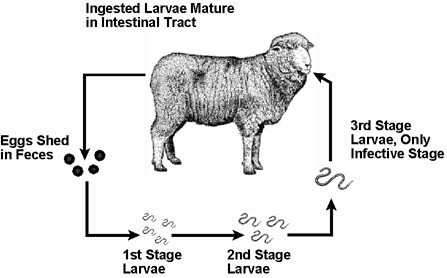
Fluke
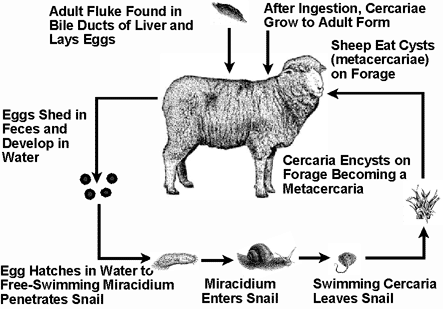
External Parasite Life Cycles:
Lice
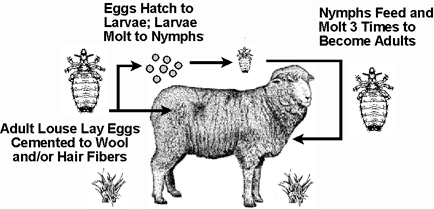
Mites
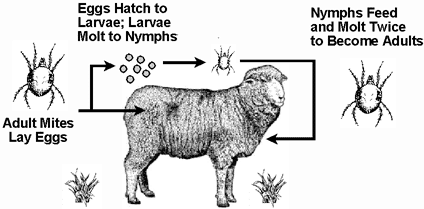
Nasal Bot Fly
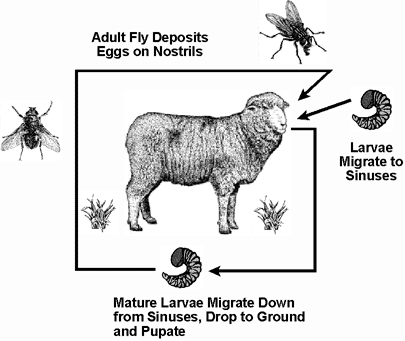
Blowfly
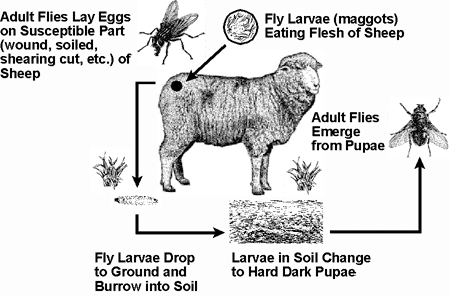
One Host Tick
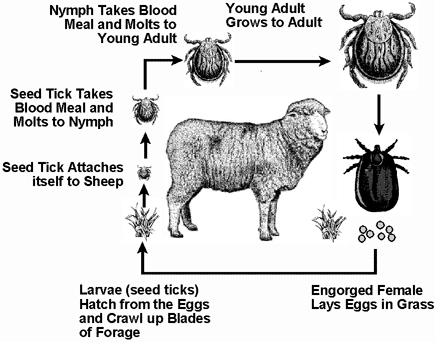
Two Host Tick
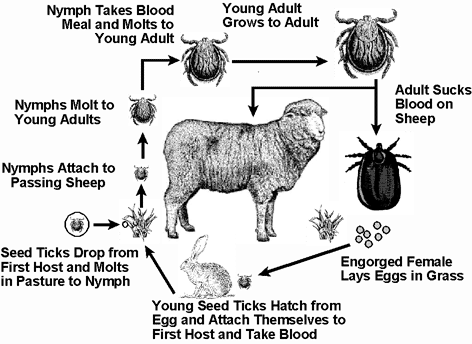
Common Parasites in Sheep and Goats:
| Parasite | Description | Symptoms/Site of Disease | Geographic Area, Environment | Prevention | Miscellaneous |
|
Brown stomach worm (Ostertagia spp.) |
Brown, thread-like worms that measure up to 12 mm long. Males are smaller. | Loss of weight is a symptom although this parasite is mostly accompanied by others and detection of exclusive Ostertagia infestation is difficult. The pH of the gut often rises from 2 to 7 resulting in poor digestion and increased growth of bacteria. Strongyle-type eggs appear in feces. | Universal; most prevalent in western U.S. | Pasture management is important. Anthelmintics should be administered at proper times. Adequate iron in the diet is important. | Wool production is decreased. Infected animals lose their appetite. |
|
Cooperia (Cooperia spp.) |
Brownish-red hair like worms that measure 4 to 6 mm in length. The anterior end is swollen. | Strongyle-type eggs appear in the feces of infected animals. Diarrhea often accompanies infested animals. Depression, loss of appetite, loss of weight, and lack of growth are also symptoms. | Universal | Proper pasture management aids in control along with proper anthelmintics. | Damage is not severe unless animals are heavily infected. |
|
Hookworm (Bunostomum trigonocephalum ) |
Anterior end is bent toward its back. The mouth is cup-shaped and has two cutting plates. Males are 12-17 mm long; females are 19-26 mm. | Can cause anemia, edema, and general unthriftiness. Symptoms are generally similar to those of the stomach worm. Adult worms attach to the intestinal wall and suck blood. Bleeding often continues even after the parasite is gone. | Universal; heaviest infestations in warm, moist climate of southern U.S. | Maintain well drained pastures and manage manure properly. Treat infected animals with proper anthelmintics. | Strongyle-type eggs appear in feces, but may be scarce. Animals become unthrifty when infected causing large economic losses. |
|
Intestinal threadworm (Strongyloides papillosus) |
Only the female is parasitic. They are small, threadlike worms that measure up to 6 mm long. | Site of infection is the small intestine. Can cause erosion of the intestinal lining and diarrhea. Loss of appetite can occur along with bloody diarrhea. If entry is gained through the skin, intensive itching can occur. | Universal; especially in warm, humid climates. | Administer proper anthelmintics and keep animals in clean, dry areas. | This parasite enters animals through ingestion or skin penetration. Entry through the feet can predispose animals to foot rot. |
|
Liver fluke (Fasciola hepatica ) |
Flattened, leaf-like brown worm. | A pot-bellied condition might appear. This is caused by escaped fluids from damaged liver into the body cavity. | Much the same pattern as occurs in cattle; southeastern states along the Gulf, California, northwestern U.S. and on irrigated pastures. | Anthelmintic treatment followed by good feeding program. Animals should be removed from infested ground. Wet pastures should be avoided. | Death may occur with heavy infestations without apparent symptoms. Infection can be transmitted to offspring. |
|
Lungworm (Dictyocaulus filaria ) |
White with a dark line running the full length of the worm. Length of males are 3 to 8 cm and females range from 5 to 10 cm. | Accumulation of adult worms and eggs can occur in the airways and cause obstruction. This can cause the lung tissue to collapse. Suffocation can then occur. Animals can show a symptoms by coughing and having difficulty breathing. | Universal; most prominent in warm, moist areas. | Proper pasture management is important, keeping animals away from infected areas. In addition, proper anthelmintics should be administered. Vaccination against Dictyocaulus is effective. | Serious losses can occur. Pneumonia can develop from secondary bacterial infection. |
|
Nodular worm (Oesophagostomum spp.) |
White worm with a narrowed front end. Adults measure up to 20 mm long. | Found in the cecum and colon. Larvae burrow into the wall of the gut anywhere from the stomach to the rectum. From there they enter the large intestine. Cause diarrhea. Animals might go off feed; eaten feed is often poorly digested and absorbed. | Universal; mostly in central, southern and eastern U.S. | Proper pasture management and use of anthelmintics. | Ingestion of the third-stage larvae produces infection. Wool and meat production are impaired. If nodules rupture in the abdominal cavity, infection can result in death. Damage is caused to the intestines, making them unsatisfactory for use in making sausage. This is a significant loss. |
| Stomach hair worm or bankrupt worm (Trichostrongylus axei ) | The adult worm measures only 0.5 cm and is hair-like. | The adult worm can penetrate the lining of the abomasum. Wart-like swellings may occur in these areas and cause diarrhea. | Universal | Reduce populations of infective larvae on pastures. | Serious weight loss can occur along with poor weight gain. Young animals are most susceptible. |
|
Stomach worm, wire worm, twisted barber-pole worm (Haemonchus contortus ) |
Measure 10 to 30 mm long. Females have white ovaries wound spirally around the red intestine giving a barber-pole appearance. Males are completely red. | Cases that are not fatal produce weakness in animals. Anemia is the most pronounced problem. Other problems include edema (bottle-jaw) and wool breaks. The parasite punctures blood vessels in the stomach wall and feeds on the blood that is released. | Universal; Incidence is greatest in warm, wet areas. | Self-immunity can occur. Use recommended anthelmintics for control. Pastures should be rotated on two-week intervals. | This parasite problem precludes profitable sheep production in southwestern U.S. Young animals are apt to die from infestations. Death can occur while animals appear to be in good health. |
|
Tapeworm (Moniezia expansa and Thysanoma actinoides ) |
Length may be up to 600 cm. They are long, flat and ribbon-like in appearance. The body of the adult consists of hundreds of segments which are essentially egg-filled (gravid) sacs (proglottid) that break off and pass into the feces. | There are no specific symptoms but infestation can cause loss of weight and poor wool production. Proglottid resembling cooked rice grains sometimes appear in feces of infested animals. | Universal; young animals are more susceptible than adults. | Proper anthelmintics and pasture management. There is an apparent acquired immunity in animals over one year of age. | The major concern with this parasite is that it robs the host of nutrients. |
|
Thread-necked strongyle (Nematodirus spp.) |
Body is long and thin measuring from 10 to 30 mm in length. The head is larger than the tail end. | Diarrhea and dehydration occur. Loss of appetite and weight may occur. | Universal | Pasture management and anthelmintics control this parasite. | Both larvae and eggs are resistant to extreme cold. |
|
Lice (Linognathus spp.) |
Wingless with sucking mouthparts. The head is long and narrow. | Mostly found on the legs and feet where the animal is free of hair. Infested animals go off feed. Wool and growth are inhibited. Scratching can cause wool breaks. Signs of infestations can be matted or cotted fleece. | Universal | Insecticides on the animals. If animals are confined, the building can be fumigated. | Causes economic loss in lack of growth and poor wool quality. |
|
Mites (Psoroptes communis ovis) |
Circular in shape and very small. All its legs project beyond its body. | Locate in heavily wooled areas such as the shoulders, sides, and back. Causes loss of weight, wool loss and death in severe cases. Infested animals show signs of rubbing and eventually have raw skin exposed. | Universal; only found sporadically in the U.S. | Dipping, spraying, jetting, etc., with proper chemicals are most effective. Entire flock must be done at the same time. | Highly contagious causing rapid spread. |
|
Nose or nasal bot (Oestrus ovis) |
The grayish-brown adult flies measure 12 mm in length. Young larvae are nearly white in color and develop dark transverse bands on their upper surface as they mature. They reach 3 cm in length. | Adult flies deposit larvae around the nostrils of the host (sheep) which then crawl into the nasal and frontal sinuses. The full-grown larvae crawl out of the nose and pupate on the ground. Infested sheep show unthriftiness, loss of appetite, nasal irritation and discharge, and sneezing. The flies are often difficult to detect unless the sheep dies. | Universal | Oral doses of systemic insecticides or fumigation. | A complication that can result from infestations of the nose bot is migration of the larvae through the skull where it injures the brain, causing neural incoordination and other nervous disorders. |
|
Sheep ked (Melophagus ovinus) (Often mistakenly called a sheep tick [8 legs], actually a wingless fly [6 legs].) |
Hairy, bloodsucking, wing-less fly that measures 4 to 6 mm long. The legs are strong and have claws at the end. | Infested animals show a marked reduction in condition along with biting and scratching. The wool also becomes stained by ked feces. Most infestations occur on the neck, shoulders and belly. As the sheep rub the fleece becomes damaged. A raised blemish on the pelt known as “cockle” can occur reducing the value of the pelt. | Universal; Infestations are generally worse in winter months and the cooler climates. | Dips and sprays can be used effectively. Treatment of infested animals should be given after shearing since shorn sheep offer little protection to the sheep ked. One application of insecticide per year should be adequate. | Poorly managed animals are more apt to become infested. These parasites spend their entire life on the animal. |
|
Wool maggots (Chrysomyia spp., Lucillia sericata) |
Blowflies are 8 to 10 mm long and bluish-green in color. | Attach to sheep having open sores, dirty wool from lambing, or wool soiled from urine or feces. The flies lay their eggs in these dampened and dirty areas. Maggots hatch and begin to feed. Infested sheep will lay along fence lines or in shaded areas. When forced to move they will kick the hind legs showing irritation. Production is lowered. | Universal; mostly in the Pacific Northwest, the South, and Southwest. | Wool around infested areas should be shorn. Treatment can then be administered. | Open sores infested by the maggots may become infected with bacteria causing animals to die. It is a severe problem economically. |